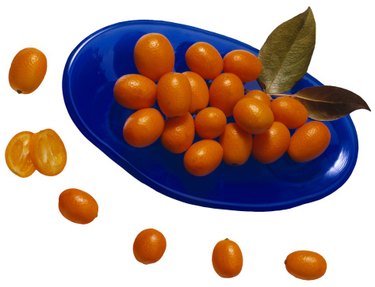
Orange fruits aren't limited to actual oranges and grapefruits -- there are plenty of other orange-colored fruits that you can add to fruit salads and desserts. The trees these fruits grow on, often small and shrub-like, are sometimes just as attractive as the fruits themselves. Some require specific conditions like warm weather and rich soil to yield the tastiest fruit.
Peanut Butter Fruit Tree
Video of the Day
Peanut butter fruit trees are small enough to be classified as a shrub; the plant requires well-drained soil and thrives in soil fortified with organic fertilizer. The leaves are large, dark green, and curl slightly at the edges and the flowers are small and yellow. Peanut butter fruits ripen during late spring and summer and boast an intense orange or near-red color. The small fruits are about an inch long at maturity, and while they have a fruity sweetness, their texture is similar to peanut butter, make the fruit a tasty addition to milkshakes.
Video of the Day
Kumquat Tree
Kumquat trees are evergreen, and have a slow growth rate. At maturity, the small trees are between 10 and 15 feet tall, although some are as small as 8 feet tall, similar to the size of a peanut butter tree. The grass-green leaves grow alternately on the stem, are about three inches long, and have a wide sickle shape. The small, orange fruits are round or oval shaped. There are several varieties of kumquat, including the Marumi. The Marumi kumquat tree came to Florida from Japan in the late 1700s and has a pronounced acidic taste; each fruit contains one to three seeds. The Meiwa kumquat tree, also a native of Japan, yields sweet and juicy fruit that is often seedless.
Dancy Tangerine Tree
Tangerines are often smaller than oranges, and have a noticeably sweeter flavor. The Dancy tangerine tree grows well in Florid and grows upright, with thick, full foliage. The leaves are a bright shade of green and teardrop-shaped. Dancy tangerine trees are prone to Alternaria fungus disease, which requires careful control to stop symptoms such loss of foliage and smaller crops. Dancy tangerines are about 2 1/2 inches in diameter, and have thin, leathery rinds that are a deep shade of orange. The fruits reach full maturity in December and January.
Naranjilla Tree
Naranjilla trees produce small, sweet orange fruits similar in size to tangerines. They are the main ingredient in some Peruvian fruit juices. Naranjilla trees originated in Peru and are most abundant there, but also thrive in the southern regions of Colombia and Ecuador. The leaves of the tree are about two feet long and covered with an attractive purple fuzz that has a velvety feel. The tree is fairly small and sometimes considered a shrub, as it only grows to about eight feet. Dark and medium orange naranjillas grow best in warm weather, but need partial shade to thrive. The fruits are an integral part of South American desserts, used in ice cream, pie filling, and baked desserts.